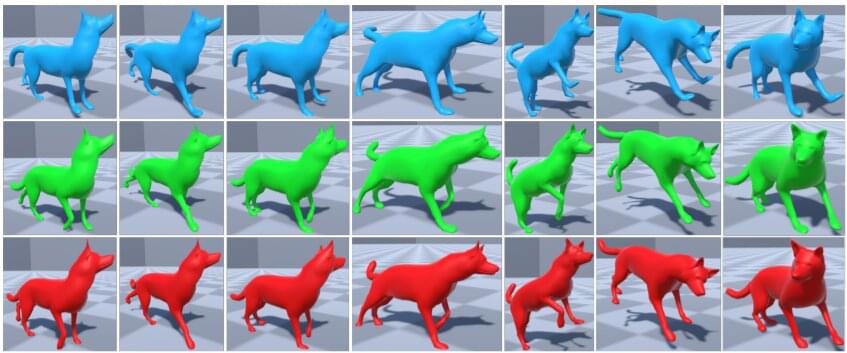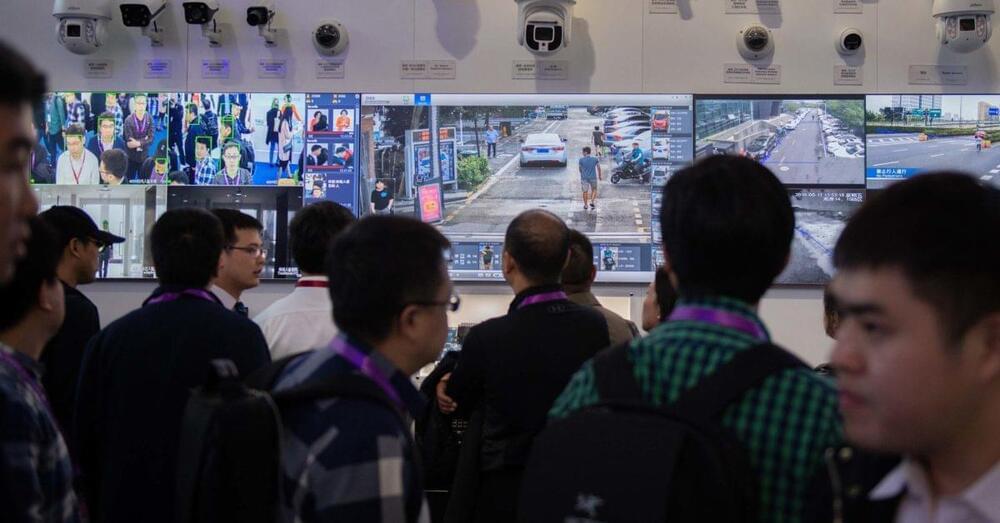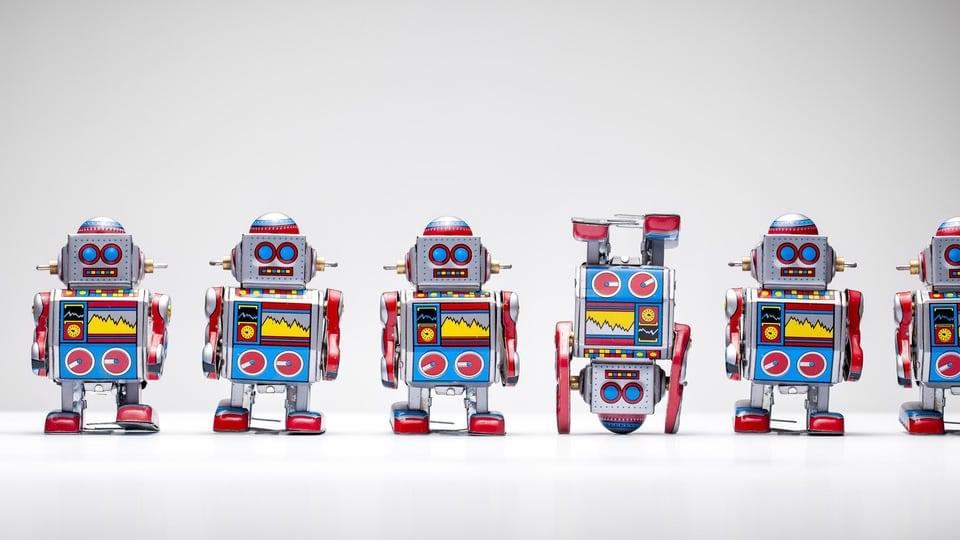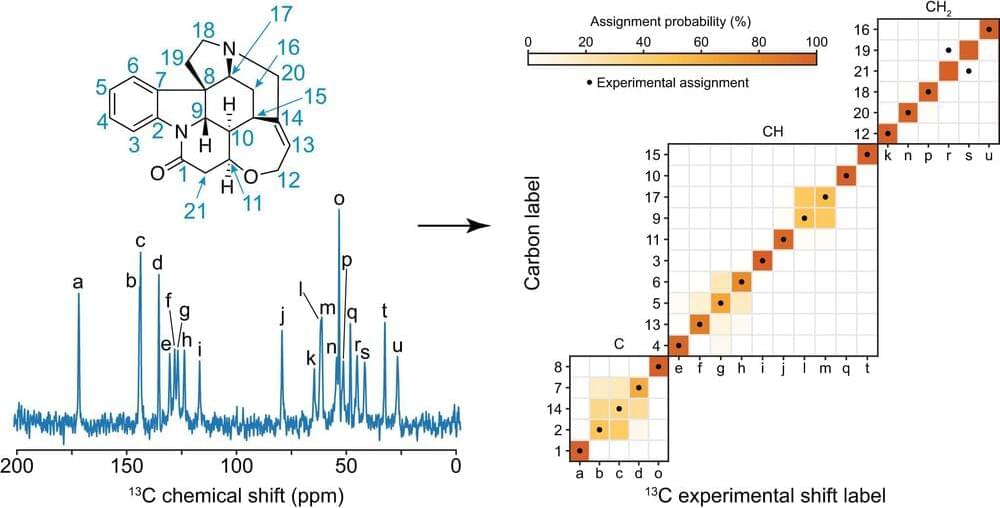Dreams are weird. According to a new theory, that’s what makes them useful.
Category: robotics/AI – Page 1,778

A deep learning method to automatically enhance dog animations
Researchers at Trinity College Dublin and University of Bath have recently developed a model based on deep neural networks that could help to improve the quality of animations containing quadruped animals, such as dogs. The framework they created was presented at the MIG (Motion, Interaction & Games) 2021 conference, an event where researchers present some of the latest technologies for producing high-quality animations and videogames.
“We were interested in working with non-human data,” Donal Egan, one of the researchers who carried out the study, told TechXplore. “We chose dogs for practicality reasons, as they are probably the easiest animal to obtain data for.”
Creating good quality animations of dogs and other quadruped animals is a challenging task. This is mainly because these animals move in complex ways and have unique gaits with specific footfall patterns. Egan and his colleagues wanted to create a framework that could simplify the creation of quadruped animations, producing more convincing content for both animated videos and videogames.

Meet the robot that can write poetry and create artworks
When people think of artificial intelligence, the images that often come to mind are of the sinister robots that populate the worlds of “The Terminator,” “i, Robot,” “Westworld,” and “Blade Runner.” For many years, fiction has told us that AI is often used for evil rather than for good.
But what we may not usually associate with AI is art and poetry — yet that’s exactly what Ai-Da, a highly realistic robot invented by Aidan Meller in Oxford, central England, spends her time creating. Ai-Da is the world’s first ultra-realistic humanoid robot artist, and on Friday she gave a public performance of poetry that she wrote using her algorithms in celebration of the great Italian poet Dante.
The recital took place at the University of Oxford’s renowned Ashmolean Museum as part of an exhibition marking the 700th anniversary of Dante’s death. Ai-Da’s poem was produced as a response to the poet’s epic “Divine Comedy” — which Ai-Da consumed in its entirety, allowing her to then use her algorithms to take inspiration from Dante’s speech patterns, and by using her own data bank of words, create her own work.


AI That Tries To Be Funny Is Not Necessarily A Laughing Matter, Especially When Used By Self-Driving Cars
Humor can be quite useful.
Let’s see how.
Suppose you are having a bad day (I realize this seems a bit dour and gloomy, but the venerated gallantry of well-placed humor will turn this around, wait and see).
While on the way home from work, you opt to use a ridesharing or ride-hailing service. After settling into the car and getting ready to have a quiet and solemnly introspective ride home, the driver suddenly speaks up and tells you an entertaining joke that causes you to laugh out loud. The merriment of the humorous anecdote sparks you to get out of your dismally sour mood. It was one of the best jokes you have ever heard, a knee-slapping and side-splitting piece of humor.
Things are looking up, and when you arrive home, your perspective and attitude about the world have shifted into one of peacefulness and content.
All due to letting some humor enter into your day.
Full Story:
The Epistemology of Deep Learning — Yann LeCun
Deep Learning: Alchemy or Science?
Topic: The Epistemology of Deep Learning.
Speaker: Yann LeCun.
Affiliation: Facebook AI Research/New York University.
Date: February 22, 2019
For more video please visit http://video.ias.edu
Time: Do the past, present, and future exist all at once? | Big Think
Watch the newest video from Big Think: https://bigth.ink/NewVideo.
Learn skills from the world’s top minds at Big Think+: https://bigthink.com/plus/
Everything we do as living organisms is dependent, in some capacity, on time. The concept is so complex that scientists still argue whether it exists or if it is an illusion. In this video, astrophysicist Michelle Thaller, science educator Bill Nye, author James Gleick, and neuroscientist Dean Buonomano discuss how the human brain perceives of the passage of time, the idea in theoretical physics of time as a fourth dimension, and the theory that space and time are interwoven. Thaller illustrates Einstein’s theory of relativity, Buonomano outlines eternalism, and all the experts touch on issues of perception, definition, and experience. Check Dean Buonomano’s latest book Your Brain Is a Time Machine: The Neuroscience and Physics of Time at https://amzn.to/2GY1n1z.
TRANSCRIPT: MICHELLE THALLER: Is time real or is it an illusion? Well, time is certainly real but the question is what do we mean by the word time? And it may surprise you that physicists don’t have a simple answer for that. JAMES GLEICK: Physicists argue about and physicists actually have symposia on the subject of is there such a thing as time. And it’s also something that has a traditional in philosophy going back about a century. But, I think it’s fair to say that in one sense it’s a ridiculous idea. How can you say time doesn’t exist when we have such a profound experience of it first of all. And second of all we’re talking about it constantly. I mean we couldn’t get, I can’t get through this sentence with out referring to time. I was going to say we couldn’t get through the day without discussing time. So, obviously when a physicist questions the existence of time they are trying to say something specialized, something technical. BILL NYE: Notice that in English we don’t have any other word for time except time. It’s unique. It’s this wild fourth dimension in nature. This is one dimension, this is one dimension, this is one dimension and time is the fourth dimension. And we call it the fourth dimension not just in theoretical physics but in engineering. I worked on four dimensional autopilots so you tell where you want to go and what altitude it is above sea level and then when you want to get there. Like you can’t get there at any time. GLEICK: Einstein or maybe I should say more properly Minkowski, his teacher and contemporary, offers a vision of space-time as a single thing, as a four dimensional block in which the past and the future are just like spatial dimensions. They’re just like north and south in the equations of physics. And so you can construct a view of the world in which the future is already there and you can say, and physicists do say something very much like this, that in the fundamental laws of physics there is no distinction between the past and the future. And so if you’re playing that game you’re essentially saying time as an independent thing doesn’t exist. Time is just another dimension like space. Again, that is in obvious conflict with our intuitions about the world. We go through the day acting as though the past is over and the future has not yet happened and it might happen this way or it might happen that way. We could flip a coin and see. We tend to believe in our gut that the future is not fully determined and therefore is different from the past. DEAN BUONOMANO: If the flow if time, if our subjective sense of the flow of time is an illusion we have this clash between physics and neuroscience because the dominant theory in physics is that we live in the block universe. And I should be clear. There’s no consensus. There’s no 100 percent agreement. But the standard view in physics is that, and this comes in large part from relativity, that we live in an eternalist universe, in a block universe in which the past, present and future is equally real. So, this raises the question of whether we can trust our brain to tell us that time is flowing. NYE: In my opinion time is both subjective and objective. What we do in science and engineering and in life, astronomy, is measure time as carefully as we can because it’s so important to our everyday world. You go to plant crops you want to know when to plant them. You want to know when to harvest them. If you want to have a global positioning system that enables you to determine which side of the street you’re on, from your phone you need to take into account both the traditional passage of time that you might be familiar with watching a clock here on the Earth’s surface, and the passage of time as it’s affected by the… Read the full transcript at https://bigthink.com/videos/does-time-exist

Can AI Truly Give Us a Glimpse of Lost Masterpieces?
Recent projects used machine learning to resurrect paintings by Klimt and Rembrandt. They raise questions about what computers can understand about art.
Full Story:
IN 1945, FIRE claimed three of Gustav Klimt’s most controversial paintings. Commissioned in 1,894 for the University of Vienna, “the Faculty Paintings”—as they became known—were unlike any of the Austrian symbolist’s previous work. As soon as he presented them, critics were in an uproar over their dramatic departure from the aesthetics of the time. Professors at the university rejected them immediately, and Klimt withdrew from the project. Soon thereafter, the works found their way into other collections. During World War II, they were placed in a castle north of Vienna for safekeeping, but the castle burned down, and the paintings presumably went with it. All that remains today are some black-and-white photographs and writings from the time. Yet I am staring right at them.
Well, not the paintings themselves. Franz Smola, a Klimt expert, and Emil Wallner, a machine learning researcher, spent six months combining their expertise to revive Klimt’s lost work. It’s been a laborious process, one that started with those black-and-white photos and then incorporated artificial intelligence and scores of intel about the painter’s art, in an attempt to recreate what those lost paintings might have looked like. The results are what Smola and Wallner are showing me—and even they are taken aback by the captivating technicolor images the AI produced.
Let’s make one thing clear: No one is saying this AI is bringing back Klimt’s original works. “It’s not a process of recreating the actual colors, it is re-colorizing the photographs,” Smola is quick to note. “The medium of photography is already an abstraction from the real works.” What machine learning is doing is providing a glimpse of something that was believed to be lost for decades.
SmartFarm harvests air moisture for autonomous, self-sustaining urban farming
Advanced hydrogel used in SmartFarm was also tested for space-based agriculture.

Machine learning solves the who’s who problem in NMR spectra of organic crystals
Solid-state nuclear magnetic resonance (NMR) spectroscopy—a technique that measures the frequencies emitted by the nuclei of some atoms exposed to radio waves in a strong magnetic field—can be used to determine chemical and 3D structures as well as the dynamics of molecules and materials.
A necessary initial step in the analysis is the so-called chemical shift assignment. This involves assigning each peak in the NMR spectrum to a given atom in the molecule or material under investigation. This can be a particularly complicated task. Assigning chemical shifts experimentally can be challenging and generally requires time-consuming multi-dimensional correlation experiments. Assignment by comparison to statistical analysis of experimental chemical shift databases would be an alternative solution, but there is no such database for molecular solids.
A team of researchers including EPFL professors Lyndon Emsley, head of the Laboratory of Magnetic Resonance, Michele Ceriotti, head of the Laboratory of Computational Science and Modeling and Ph.D. student Manuel Cordova decided to tackle this problem by developing a method of assigning NMR spectra of organic crystals probabilistically, directly from their 2D chemical structures.